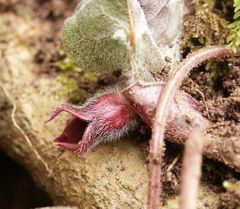Asarum europaeum
| Asarum europaeum subsp. var. | ||||||||||||||||||||||||||||||||||||||||||||||||||||||||
|---|---|---|---|---|---|---|---|---|---|---|---|---|---|---|---|---|---|---|---|---|---|---|---|---|---|---|---|---|---|---|---|---|---|---|---|---|---|---|---|---|---|---|---|---|---|---|---|---|---|---|---|---|---|---|---|---|

|
|
| ||||||||||||||||||||||||||||||||||||||||||||||||||||||
| ||||||||||||||||||||||||||||||||||||||||||||||||||||||||
Asarum europaeum, or Asarabacca, European Wild Ginger, Haselwort, and Wild Spikenard, is a European species of wild ginger (Asarum) with single axillary dull purple flowers, lying on the ground. The stems are 10-15 cm long. The leaves are petiolate and reniform and about 10 cm wide. It occurs mostly in deciduous woodland or coniferous forests. In former days, it was used in snuff. It is quite shade-tolerant. An excellent choice for a ground cover where little else will grow.
| Standard Cyclopedia of Horticulture |
|---|
|
Asarum europaeum, Linn. Lvs. kidney-shaped, evergreen, dark green, the petiole 3-5 in.: fls. greenish purple, ½in., with incurved lobes; styles 6, and grooved or 2- parted, recurved. Eu.
|
Cultivation
Propagation
Pests and diseases
Varieties
Gallery
-
Leaves
-
photo 1
-
photo 2
-
photo 3
References
- Standard Cyclopedia of Horticulture, by L. H. Bailey, MacMillan Co., 1963
External links
- w:Asarum europaeum. Some of the material on this page may be from Wikipedia, under the Creative Commons license.
- Asarum europaeum QR Code (Size 50, 100, 200, 500)

